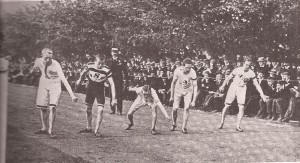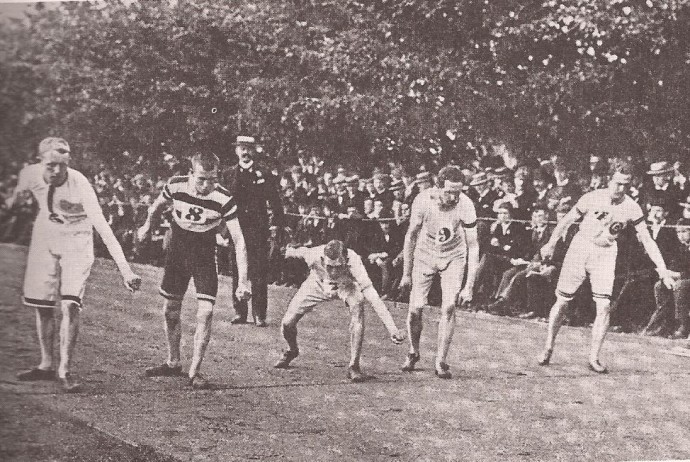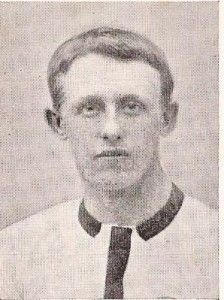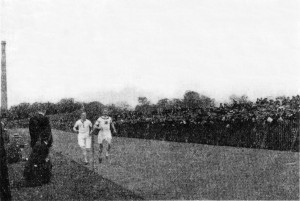Hugh Welsh (born on 20th September, 1876) from Edinburgh was said to be the best miler in Britain in the second half of the 1890’s bar none. This will be clear by the end of the profile. His background in the sport is described well in an article in ‘The Scots Athlete’ for August 1947 which describes his most famous race, that against Alf Tysoe in May 1898. He says this about Welsh: “Hugh Welsh was an athlete from his childhood days, being as it were, to the manner born. Even in his preparatory school days, as a pupil of George Watson’s Boys’ College, he was recognised by his companions as a formidable opponent in all their games, and his later achievements on the running track, indeed, at this distance in time are still recalled with pride by all Watsonians. He really began his brilliant, though short, athletic career a s a lad of 15 years among the beauties of the Pentland Hills, on the occasion of a Sunday School picnic to Habbies Howe, a hamlet situated south of Edinburgh. On this occasion the suggestion of a teacher that a footrace to the top of a nearby hill (Carnethy) and back be organised for the older scholars, was immediately agreed upon. Among the starters was Hugh Welsh, and his arrival at the winning post several minutes before his nearest rival was the first visible evidence to his friends of his wonderful gift of stamina and speed which Nature had bestowed upon him. Whilst yet in his early ‘teens, Welsh was soon competing against more experienced opponents and by his successes gaining high praise from the athletic pundits of that time. His many honours on thje track included SAAA, IAAA and AAA titles, International selections and triumphs in the less exalted sphere of Handicap events, adding his name, incidentally, to that dubious category of athletic distinction as a record holder.”
His first SAAA medal was silver rather than gold, but the start of a notable career in athletics at the age of 16 years. The slowest ever winning mile time in the Scottish championships was set in 1894 when, with only two competitors, the winning time was 5 minutes 36 seconds. James Rodger of Carrick Harriers won with 17-year old Hugh Welsh of Watsonians second. The pace was funereal – but the last lap was in 54 seconds! The first four laps averaged 94 seconds each. He had not appeared very often in the results columns earlier in the year, but the preview of the championships in the ‘Glasgow Herald’ read: The half-mile will be another good race. Welsh, of the Watsonians, has entered; his form over this distance is unknown, but he must have been doing something fair or he would not have entered. Still, we hardly think he will be able to outrun either Mitchell or Rodger, who are the strongest candidates for this distance. As regards the Mile, if time performances go for anything, there is only one runner in it, J Rodger of Maybole. His performance at the ‘West’ Harriers Sports – 4 min 31 2-5th secs – we look upon as next in point of merit to DS Duncan’s record – 4 mins 28 secs. …. It is said that Welsh will be Rodgers’ hardest opponent. Welsh will not run in the Four Miles race, which is a wise decision, seeing he is only yet 18 years of age.” This was the only time that Welsh was defeated in the SAAA championships and he went on to do the 880/Mile double several times in the championships and even did it in the Irish international.
In 1895, the SAAA championships were challenged by the breakaway SAAU holding their version of Scottish championships on the same day and there were various issues in play which led to the SAAA Championships being poorly supported by the paying public and athletic talent split between the two meetings. Welsh did not run in either of them. Nevertheless on his known form he was selected for the first ‘Scoto-Irish’ international (as it was known) and on 20th July at Celtic Park he won the Mile in 4:33 from Ireland’s JJ Mullen of Elysian Harriers.
He was in action the following year, 1896, however to the extent that he won both 880 yards and One Miles titles. In the 880 yards he won in 2:04 from W Hay and in the Mile his time was 4:32 with J Stirton second. This double was only the first of the summer – on 18th July at Ball’s Bridge in Dublin, in the International, he won the 880 yards in 2:01.4 from Ireland’s JE Finnegan, and the Mile in 4:33 from JJ Mullen – the same JJ Mullen that he had beaten in 4:33 the previous year! “He Welsh created a surprise in defeating Mullen in the Mile; but as the Irishman was just recovering from a sharp illness, it is evident that under other circumstances this, like the majority of events, would have fallen to our rivals.“ The ‘Glasgow Herald’ was not impressed by a Scottish victory, then. Nevertheless what would nowadays be called a ‘double’ at the national championships plus an international victory constituted a good season’s work.
Into 1897 the championships were held at Celtic Park on 26th June and Welsh was again in action. As in 1896, Welsh won both 880 yards and One Mile, but the races were a wee bit harder in that the two feuding organisations had come together and in the joint SAAA/SAAU meeting, he defeated opponents from the West. W Robertson of Clydesdale Harriers was a very good runner who had set a Scottish record of 4:27.2 at the SAAU championships in June 1896 but Welsh won the head-to-head in 4:24.2. In the 880 yards he won in 2:02 from J Barclay.
John Keddie in ‘Scottish Athletics’ gives us more information on the 1897 season saying. “SAAA champion in 1896, Hugh Welsh’s first incursion into the record books took place at the following year’s united SAAA and SAAU meeting at Celtic Park when he won the mile in 4:24.2. The following week he was down at Fallowfield, Manchester, for the AAA event which was to prove an unhappy affair as in the course of the race he was spiked in the back of the leg, lost a running shoe and hobbled in well behind. Salford Harrier Alfred E Tysoe went on to win the race in 4:27.0, a time well within Hugh Welsh’s capability. The Englishman was said to have been unhappy with the circumstances of his victory, in addition to which a lively correspondence ensued between the SAAA and the AAA over the ‘incident’, but in the event no action was taken.
As a result Tysoe was keen to have an opportunity of demonstrating his superiority and readily agreed to a challenge match with Welsh the following May. This to be held at Powderhall on the 30th in conjunction with Watson’s College Games and the winner was to receive a special forty guinea silver cup. In deference to the Englishman the race was run left-hand-in (ie anti-clockwise) though normally in Scotland at that time races were run right-hand-in. The event quickened public interest, not least because of the popularity of Tysoe north of the border and a sizeable and enthusiastic crowd gathered to see the race. There was a buzz of excitement as the contestants went to the start. Tysoe (5’7/1.70 and 147lbs/66kg) drew the inside position but when the starter, John Davidson (a well-known Powderhall starter) sent them off it was Welsh (5’8″/1.73 and 142lbs/65kg) who showed ahead first. The first lap took 62.4 seconds, both athletes running comfortably. The second lap, with the Scot still ahead, occupied 68.0. With excitement rising, Tysoe forged ahead at the end of the third lap – covered in 71.2 – and entered the back straight (actually the stand straight at Powderhall) with what appeared to be a good lead. This he sustained, urged on by his supporters and came into the home straight a good 10 yards to the good. Had Welsh met his match? He seemed outclassed. But just then the young Scot made a wonderful effort, long to remain a talking point in Scottish athletic circles. He raised his pace, caught the Englishman fifty yards from the tape, and simply left him standing, leaping through the tape with hands held high. The crowd were electrified and enthusiastically cheered both runners in a spontaneous tribute to a marvellous race. And the time? Almost incidentally the winner’s 4:23.75 was a new Scottish record. This was one of the great moments in Scottish athletics.”
However, the ‘Glasgow Herald’ report on the race said “It may be assumed that we have not heard the last of the Welsh-Tysoe rivalry. The pair ran a grand race at the Watsonian meeting in Edinburgh on Saturday, but if, as is stated, Tysoe ran the last 100 yards in difficulties, his legs troubling him, it may be taken for granted that his friends will not lose the first opportunity in pitting him against his conqueror. All the same, Welsh’s performance may give them pause. He made the most of the pace in a tugging wind, and he actually had to give Tysoe four yards in the last 120, Welsh’s own friends giving him up on the last bend when he seemed labouring and was losing ground. His magnificent sprint which fairly ran Tysoe off his feet, showed his marvellous resource,and his grand judgment was also manifested. Last year he ran six yards over the mile at Parkhead in 4 mins 24 1-5th sec; on Saturday he clocked 4 mins 23 3-5th sec and thus lowered his own Scottish native record. The dual performance caused as much excitement and enthusiasm as did the greatest of Downer’s performances, and the race is bound to do something for athletics in the capital.”
This race, and the backgrounds of both men, is covered in vivid detail in ‘The Scots Athlete’, Vol 2, Number 5, of August 1947 and can be found at http://salroadrunningandcrosscountrymedalists.co.uk/Archive/The%20Scots%20Athlete%20Volumes/Volume%202/SA%20Vol%202,5.pdf where it is on pages 10 – 13 inclusive. Very well worth a visit.
His next major triumph was in the AAA’s championships at Stamford Bridge on 2nd July. “The first event on the programme was probably the most important, particularly as far as Scotsmen are concerned, inasmuch as Welsh, the Watson’s College youth, for the first time this season would be pitted against foemen worthy of his steel. Only five of the nine entrants started, the absentees including AE Tysoe, last year’s champion; Orton of the New York Athletic Club; Hunter of Cambridge; and Collins, Essex Beagles. The five starters were B Lawford, EAC (1896 champion); DG Harris, Reading; AW Tovey, Highgate Harriers; WE Lutyens, Cambridge College; and Welsh. Welsh secured first pick of position and chose inside berth, and when the pistol fired Lawton immediately shot to the front and cut out a hottish pace, Welsh contenting himself with second position. In the second round Lutyens began to assert himself, and for a moment the hopes of the Scottish contingent were blighted by the easy style of the old Blue. The tactics of Welsh did not allay his supporters’ fears from the repeated apprehensive glances he cast over his shoulder at his men behind, while he seemed to ignore Lutyens efforts to secure a permanent lead. So the race lasted until 300 yards from home, when it was easily seen that Welsh was gaining on Lutyens with every stride he took. The question arose, however – would Welsh hold out? But on entering the straight the Scotsman put aside all doubt by sprinting in a manner that surprised everybody, passing Lutyens halfway down the straight and finishing as strong as a thoroughbred, in front of his rival by a good 25 yards. The time was returned as 4 min 17 1-5th sec, and considering that a fairly stiff breeze was blowing down the back straight, we feel certain that had Welsh been pushed, he could have easily broken Bacon’s British amateur record of 4 mins 17 sec by a couple of seconds.”
 AAA’s Mile, 1898. Welsh on the left
AAA’s Mile, 1898. Welsh on the left
Welsh did not race as often as many of his contemporaries and the Herald commented on this in a preview of a race in May 1897 when it said “Welsh, the champion, is uncertain. He is very closely confined as to business, and that is why he appears so seldom in public.”
The Irish International in 1898 was held on 17th July at Ball’s Bridge in Dublin and Welsh tackled both 880 yards and Mile successfully again. He won the 880 in 2:04 from CH Dickenson of Ireland, and took the Mile in 4:21.4 from CR Faussett of Ireland. The only title he did not win in 1898 was the SAAA championship.
A very good half miler as well as a miler, his best race at the distance was on 10th June, 1899 at Edinburgh. Tysoe was again in the field, and Tysoe held the Scottish all-comer’s record of 1:57.8. Another race that turned into a duel with Tysoe taking the pace out hard to attempt to remove Welsh’s finish. He failed and Welsh surged past with 150 yards to go to win by 5 yards in a new native record of 1:59.4. He had given up athletics by 1900 and Tysoe and Bennett both ran well in the Olympics. If only ….. and what if…?
He made the failure to win the SAAA in 1898 good in 1899 when he again ‘did the double’ on 24th June at Hampden, by winning the 880 in 2:0.8 from W Fitzherbert and the Mile in 4:38.8 from JC MacDonald. “Hugh Welsh did not exert himself in the mile; all he wanted was victory and this he had no difficulty in securing from JC MacDonald , who had the magnanimity to turn out to save the race from being a farce.” The half-mile was a different story altogether. “Welsh’s time in the half-mile is very fine, and under normal weather conditions his own native record of a few weeks ago would have been lowered. Fitzherbert, the old Cambridge University athlete, made a bold effort to secure this race and up to 70 yards from home, the race looked a safe thing for him. At this point, however, Welsh put in a marvellous sprint , and with every stride drew away from the Englishman, and eventually won by seven or eight yards. This was unquestionably the finest effort of the afternoon.”
Having won them both for the third time he headed for England and the AAA’s championship again but this time only tackling the Mile although, as the papers of the time said, his winning time at the shorter distance in Glasgow would have put him in with a chance. How did he do? “For the second year in succession, Hugh Welsh of Watsonians has won the English mile championship. Though his time – the permanent test of excellence – at Wolverhampton is much inferior to what it was last year at Stamford Bridge, when with a little extra steam he might have lowered George’s amateur record, the performance nevertheless is a very creditable one. For it should be kept in mind that the track at Wolverhampton is a much slower than that at Stamford Bridge, and while the conditions at London last July were almost perfect for running, the weather on Saturday was disagreeable in the extreme. But after making due allowance for these adverse circumstances, there is no getting away from the fact that Welsh is several seconds slower this season than last. This is not to be wondered at when it is borne in mind that last summer he lived in Cockermouth, where the air is pure and invigorating, while this summer he has done all his training at Motherwell where the air is neither pure nor invigorating. All that can be said about Welsh’s running this season, is that it equals his best home performance, and we have no doubt that had he been asked to do more on Saturday, he could have done it. C Bennett who ran him so close, is a very good miler and only a few days ago he lowered the English amateur record for one mile and a half. Welsh will bring his season to a close with the international match against Ireland on the 15th; it is even hinted that this will be his final appearance on the track, but it is to be hoped that he will see his way to depart from this resolution. In so short a time few, if any, have accomplished as much as Hugh Welsh, and it is the thought of additional possibilities that makes one regret that a fortnight hence he may make his final appearance.”
He did indeed turn out in the international fixture on 15th July at Powderhall and again won his two events – the 880 yards 2:03.8 and the Mile in 4:32.6 from J McKenzie and J Finnegan of Ireland. 1889 had brought him two gold medals in the SAAA, another at the AAA’s, a Scottish record in the half-mile and the two victories in the Irish match which helped Scotland win by 6 events to 5. Unfortunately he kept his word and retired after this meeting.
Keddie tells us that Welsh was a factor of estates who moved from Motherwell to Carlisle in 1902. His early retirement after a career in which he had never, according to those who saw him run or competed against him, fully extended himself, doing only enough to win led to all the questions about what could he have done.
Welsh v Tysoe: Powderhall, September 1898


